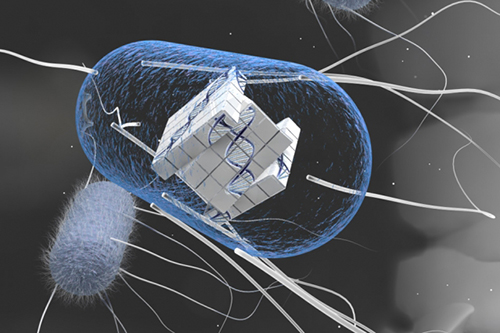![Synthetic biologists install recombinase-based state machines into living cells. Such biological circuitry responds differently depending on both the nature and the order of inputs. Potential applications include tracking disease progression and influencing cell differentiation. [Synthetic Biology Group, Research Laboratory of Electronics/MIT]](https://genengnews.com/wp-content/uploads/2018/08/Jul22_2016_MIT_Stimuli8010415297-1.jpg)
Synthetic biologists install recombinase-based state machines into living cells. Such biological circuitry responds differently depending on both the nature and the order of inputs. Potential applications include tracking disease progression and influencing cell differentiation. [Synthetic Biology Group, Research Laboratory of Electronics/MIT]
Computational systems as diverse as vending machines, computers, and cells have something in common: They are all finite-state machines. That is, they may have an initial state, accept inputs, pass to different states according to the inputs received, and even enter states that lead to specific outputs. This kind of activity has been exploited in cells, but not with the degree of control we take for granted with the humble vending machine, which can dispense the right snacks depending on whether we press, say, B4 or C2. The vending machine can even refuse to dispense anything until a certain threshold has been surpassed (the right combination of coins).
In hopes of installing this kind of control into cells, MIT scientists have developed a way to program cells to respond to up to three different inputs. Crucially, the programming is capable of recognizing the order of inputs and responding accordingly. Although three inputs permit just 16 states, the MIT researchers point out that their method is scalable. It could accommodate additional inputs and thereby enable many additional states, enough to permit complex processes such as disease progression and cell differentiation to be tracked. The new synthetic biology approach could even make it possible to intervene in these processes, leading to cancer therapies or guiding the outcome of stem cell development.
Details of the new approach appeared July 22 in the journal Science, in an article entitled, “Synthetic Recombinase-Based State Machines in Living Cells.” The article describes how MIT scientists led by Timothy Lu, Ph.D., followed up on earlier work in which cell circuits were designed that could perform a logic function and then store a memory of the event by encoding it in DNA.
In the new paper, the MIT scientists designed state machine circuits that rely on enzymes called recombinases. When activated by a specific input in the cell, such as a chemical signal, recombinases either delete or invert a particular stretch of DNA, depending on the orientation of two DNA target sequences known as recognition sites. The stretch of DNA between those sites may contain recognition sites for other recombinases that respond to different inputs. Flipping or deleting those sites alters what will happen to the DNA if a second or third recombinase is later activated. Therefore, a cell's history can be determined by sequencing its DNA.
The MIT scientists programmed Escherichia coli cells to respond to substances commonly used in lab experiments, including ATc (an analogue of the antibiotic tetracycline), a sugar called arabinose, and a chemical called DAPG. Such programming could be used with other inputs, such as acidity or the presence of specific transcription factors. In addition, cells could be programmed to not only provide a convenient readout of successive states, but also to enable the complex regulation of gene expression.
“We validated our framework by engineering state machines in Escherichia coli that used one, two, or three chemical inputs to control up to 16 DNA states,” wrote the authors of the Science paper. “These state machines were capable of recording the temporal order of all inputs and performing multi-input, multi-output control of gene expression. We also developed a computational tool for the automated design of gene regulation programs using recombinase-based state machines.”
The researchers tested their approach with three genes that code for different fluorescent proteins—green, red, and blue—constructing a circuit that expressed a different combination of the fluorescent proteins for each identity and order of two inputs. For example, when cells carrying this circuit received input A followed by input B they fluoresced red and green, whereas cells that received B before A fluoresced red and blue.
Dr. Lu's lab now hopes to use this approach to study cellular processes that are controlled by a series of events, such as the appearance of cytokines or other signaling molecules, or the activation of certain genes. “You can build very complex computing systems if you integrate the element of memory together with computation,” noted Dr. Lu, who is senior author of the current study.
“This idea that we can record and respond to not just combinations of biological events but also their orders opens up a lot of potential applications,” added Nathaniel Roquet, an MIT graduate student who is also the paper’s lead author. “A lot is known about what factors regulate differentiation of specific cell types or lead to the progression of certain diseases, but not much is known about the temporal organization of those factors. That's one of the areas we hope to dive into with our device,” Roquet says.
For example, scientists could use this technique to follow the trajectory of stem cells or other immature cells into differentiated, mature cell types. They could also follow the progression of diseases such as cancer. A recent study has shown that the order in which cancer-causing mutations are acquired can determine the behavior of the disease, including how cancer cells respond to drugs and develop into tumors. Furthermore, engineers could use the state machine platform developed here to program cell functions and differentiation pathways.


